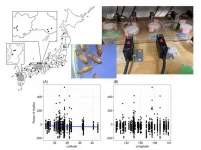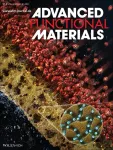Discovery of biomarker could help predict Alzheimer's years before symptoms emerge
A unique brain protein measured in the blood could be used to diagnose Alzheimer's disease decades before symptoms develop, according to new Edith Cowan University research
2021-02-18
(Press-News.org) A unique brain protein measured in the blood could be used to diagnose Alzheimer's disease decades before symptoms develop, according to new Edith Cowan University (ECU) research.
Published in Nature journal Translational Psychiatry, the study is the first to find that people with elevated glial fibrillary acidic protein (GFAP) in the blood also have increased amyloid beta in the brain, a known indicator of Alzheimer's disease.
GFAP is a protein normally found in the brain, but it is released into the blood when the brain is damaged by early Alzheimer's disease.
Alzheimer's disease affects more than 340,000 Australians and more than 35 million people in the world. Current diagnosis involves a brain scan or spinal fluid tests.
The study's lead researcher, ECU Professor Ralph Martins AO, said the discovery offered a promising new avenue for early diagnosis.
"Blood biomarkers are becoming an exciting alternative to the existing expensive and invasive methods of diagnosing Alzheimer's disease," said Professor Martins.
"The GFAP biomarker could be used to develop a simple and quick blood test to detect if a person is at very high risk of developing Alzheimer's.
"Early diagnosis is critical to allow us to implement medication and lifestyle interventions that can help delay the progression of the disease and give people more time before symptoms develop."
A step forward
Alzheimer's disease is a degenerative brain condition that can develop silently over years. It leads to memory decline and loss of thinking skills. There is no known cure.
According to Professor Martins, the development of an early blood test for the disease will be revolutionary.
"The technology for detecting biomarkers has developed rapidly, so I think we will begin to see diagnostic blood tests being used for Alzheimer's in the next few years.
"The current brain imaging and lumbar puncture tests are expensive and invasive and not widely available to the general population. A blood test could open up possibilities for early diagnosis of millions of people and thereby enable earlier interventions."
Future hope
The study involved 100 Australians aged between 65 and 90 years of age with no symptoms of Alzheimer's disease.
Professor Martins said further research is needed to understand GFAP in Alzheimer's disease.
"Longitudinal studies will provide more insight into how GFAP relates to the progression of Alzheimer's, which may allow us to determine when symptoms will emerge."
Professor Martins is also part of a large study exploring interventions for Alzheimer's disease, with the ultimate goal of finding medications and lifestyle factors that can halt or delay the development of the disease.
"Diagnosis and intervention techniques go hand in hand - if we can use blood biomarkers to detect Alzheimer's sooner, we can also intervene sooner," he said.
INFORMATION:
The study was a collaboration with Dr Pratishtha Chatterjee from Macquarie University, who is the first author on the paper.
Professor Martins is the director of the Centre of Excellence for Alzheimer's Disease Research and Care and also leads the Western Australian site of the Dominantly Inherited Alzheimer's Network (DIAN) - a global longitudinal study of people with genetically inherited Alzheimer's disease.
INFORMATION:
'Plasma glial fibrillary acidic protein is elevated in cognitively normal older adults at risk of Alzheimer's disease' was published in Translational Psychiatry.
ELSE PRESS RELEASES FROM THIS DATE:
2021-02-18
Scientists at EMBL Heidelberg and at the Zentrum für Infektiologie at Heidelberg University Hospital have succeeded for the first time in imaging HIV during transport into the nucleus of an infected cell. The electron tomographic images show the protein envelope of the virus passing through one of the nuclear pores - the openings in the membrane around the nucleus that allow molecules in and out. The scientists found that the virus passes through the nuclear pore intact, only breaking apart inside the nucleus, where it releases its genetic information. This clarifies an important mechanism by which the virus's genetic material is integrated into the genome of the infected cell.
The human immunodeficiency virus type 1 (HIV-1) - which was ...
2021-02-18
A highly porous metal organic framework, assembled from molecular building blocks designed to lock together in a specific orientation, has been developed by researchers at KAUST.
Metal organic frameworks (MOFs) are crystalline materials made from metal ions connected by organic linkers. Their internal structure is like a repeating array of tiny identical cages, which are ideal for hosting various molecules. MOFs have found potential uses from gas sensing to molecular separations to storage, depending on the dimensions and structure of their pores.
One family of MOFs has been inspired by inorganic porous materials called zeolites. Zeolites are a special class of porous material with ...
2021-02-18
One of the most intriguing features in all living beings is the "biological clock", an internal time-keeping mechanism that governs our behavioral pattern (such as the sleep-wake cycle). In fact, the biological clock dictates the developmental timing of various processes, such as when flowers bloom and insects reproduce. Biologists refer to these activities collectively as "circadian rhythms," owing to the rhythmic pattern in which they occur.
Since their discovery, circadian rhythms have been studied extensively, and today we know a great deal about how they work. ...
2021-02-18
When women undergo surgical treatment for breast cancer, they often also have reconstructive surgery but new QUT research reveals many women feel left out of the decision making.
An interdisciplinary study from researchers in QUT's Centre for Behavioural Economics, Society and Technology (BEST), Engineering Faculty, and School of Nursing, along with Dr Jeremy Hunt a Fellow of the Royal Australasian College of Surgeons and Dr Tim Peltz from the University of New South Wales, on Knowledge, consultation time and choice in breast reconstruction has just been published in the British Journal of Surgery.
"Approximately one in seven Australian women will be diagnosed with breast cancer in their lifetime," ...
2021-02-18
Most Chinese working in the cities return to work today after a 7-day public holiday of Spring Festival. The annual Spring Festival, which also marks the start of Chinese New Year, traditionally begins with the second new moon following the winter solstice, usually in January or February. Like westerners on Thanksgiving and Christmas, people across China return to their hometown to reunite with family and friends. However, the sudden outbreak of COVID-19 last year halted the largest holiday mobilization in the world. In response to the crisis, in late 2019, local governments launched ...
2021-02-18
After nearly a decade of research, a new test that detects the magnetic properties of malaria-infected blood could soon be used to help eliminate the mosquito-borne disease.
Dr Stephan Karl, a Senior Research Fellow in Malaria and Vector Biology at James Cook University's Australian Institute of Tropical Health and Medicine, has led an international study to field-test a new tool in the fight to eliminate the disease, which had 229 million reported cases in 2019.
"Malaria is easily treated but it is actually hard to diagnose, and because of that there ...
2021-02-18
Quantum computers promise not only to outperform classical machines in certain important tasks, but also to maintain the privacy of data processing. The secure delegation of computations has been an increasingly important issue since the possibility of utilizing cloud computing and cloud networks. Of particular interest is the ability to exploit quantum technology that allows for unconditional security, meaning that no assumptions about the computational power of a potential adversary need to be made.
Different quantum protocols have been proposed, all of which make trade-offs between computational performance, security, and resources. Classical protocols, for example, are either limited ...
2021-02-18
Sample pretreatment processes such as concentration or classification are essential to finding trace substances present in a fluid. In scientific communities recently, prolific research is being conducted on sample pretreatment techniques utilizing electrokinetics.1 However, due to the lack of commercial anion-permselective material - an essential component - its potential application is limited to only negatively charged particles. To this, a research team at POSTECH has found a way to isolate and concentrate only the cationic samples.
A POSTECH research team led by Professor Geunbae Lim, Ph.D. candidate Minsoo Lee, and Dr. Hyukjin J. Kwon of the Department of Mechanical Engineering developed a novel type of multiscale-porous anion exchange ...
2021-02-18
Genetic variation is like money in the bank: the more you have, the better your chances of survival in the future. Population bottlenecks decrease genetic variation, especially in endangered species. An individual's genome comprises the events that have impacted genetic variation over time, and relatively recent sequencing technologies allow us to read and interpret genetic variation across the genome. Although tigers have received significant conservation attention, little is known about their evolutionary history and genomic variation. This is especially true for Indian tigers, and ...
2021-02-18
Working with colleagues from Germany and the US, researchers at Leipzig University have achieved a breakthrough in research into how cancer cells spread. In experiments, the team of biophysicists led by Professor Josef Alfons Käs, Steffen Grosser and Jürgen Lippoldt demonstrated for the first time how cells deform in order to move in dense tumour tissues and squeeze past neighbouring cells. The researchers found that motile cells work together to fluidise tumour tissue.
Käs led the research project in cooperation with Professor Lisa Manning from Syracuse University (US) and Professor Bahriye Aktas from Leipzig University Hospital. They have now ...
LAST 30 PRESS RELEASES:
[Press-News.org] Discovery of biomarker could help predict Alzheimer's years before symptoms emerge
A unique brain protein measured in the blood could be used to diagnose Alzheimer's disease decades before symptoms develop, according to new Edith Cowan University research




